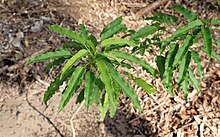Alcides metaurus
| Alcides metaurus | ||||||||||||
|---|---|---|---|---|---|---|---|---|---|---|---|---|

Alcides metaurus |
||||||||||||
| Systematics | ||||||||||||
|
||||||||||||
| Scientific name | ||||||||||||
| Alcides metaurus | ||||||||||||
| ( Hopffer 1856) |

Alcides metaurus ( Syn .: Nyctalemon zodiaca ) is a butterfly ( moth ) from the family of Spanner (Geometridae) that occursmainly in Australia.
features
butterfly
The wingspan of the moth is around 100 millimeters. The base color of the wing tops is velvety black. A narrow outer and a wide middle transverse band on the upper side of the fore wing, the middle of which continues on the upper side of the hind wing, are striking. Depending on the incidence of light, the bandages shimmer yellowish, greenish, pink or purple. The fringes and the front edge of the forewings are black and white piebald. The hind wings are strongly serrated and show a white-edged tail and also white fringes. The undersides of the wings are turquoise and crisscrossed by black cross bands. The underside of the abdomen is bright orange.
Caterpillar
The caterpillars appear in different color variations. At least 13 different versions were found, including yellow, green, orange, tartan brown, red, and black, and different combinations of these colors.
Similar species
Since the moths are predominantly diurnal, very large and colorful, and show tails on their hind wings, a cursory glance can mistake them for a butterfly from the genus Papilio . Even Carl von Linné fell victim to this fallacy , who described a similar species as Papilio orontes , which is now known as Alcides orontes . The moths of this species differ from Alcides metaurus primarily by a blue shimmer on the upper side of the wing.
distribution and habitat
The distribution of the species extends along the northeast coastal region of Queensland . It was also found in a few places in Arnhem Land and in the southeast of Papua New Guinea . Alcides metaurus prefers to colonize rainforests.
Way of life
The moths are diurnal and like to visit flowers in the morning. They can be found all year round, mainly in May, July and November. The eggs are often laid in open groups of about two dozen on plants adjacent to, but not directly on, the food plant. The females have been observed to lay their eggs on spider webs near a food plant, on dead branches or on fragments at the base of a food plant. This appears to be a response to a defense some plants have developed against caterpillars. These plants excrete a sap when an egg is laid on them. The juice makes mold grow, which would kill the egg. The caterpillars feed on the leaves of the milkweed family (Euphorbiaceae), including: Endospermum medullosum , Endospermum myrmecophilum , Omphalea papuana , Omphalea queenslandiae and Omphalea celata . These plants also contain toxins , which are stored by the caterpillars and which therefore represent an effective protection against predators. The caterpillars let themselves down on a strong and sticky silk thread in case of danger, turn their bodies after the danger has passed and climb back on the thread to their original position. The pupation occurs in a woven from silk threads cocoon between withered leaves.
Individual evidence
- ↑ a b Maya Harrison: The Zodiac Moth - A discovery and study , Metamorphosis Australia, Number 57, 2010, [1]
- ^ A b Paul Zborowski & Ted Edwards: A Guide to Australian Moths , CSIRO Publishing, Collinwood, 2007, ISBN 978-064309-1597 , p. 150
- ↑ flight times
- ↑ Zodiac Moth at butterflyhouse
literature
- Paul Zborowski & Ted Edwards: A Guide to Australian Moths , CSIRO Publishing, Collinwood, 2007, ISBN 978-064309-1597
Web links
- Lepiforum e. V. - Taxonomy and photos
- bie.ala.au - localities in Australia
- bubuleps - caterpillar

